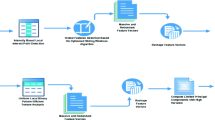Abstract
We address the problem of recognizing the object with distinctive edge features. For this purpose, a recognition approach based on local edge features is presented. First the edge features are detected in each image, and then its descriptor is computed to find the match features. Each match will give a vote with location, scale and orientation of the object. The recognition result can be found in the densest position in the vote space. Experimental results show that the presented method is robust and effective to the object with distinctive edge features.
Similar content being viewed by others
References
D. G. Lowe, “Distinctive image features from scaleinvariant keypoints,” Int. J. Comput. Vision 60 2, 91–110 (2004).
H. Bay, A. Ess, T. Tuytelaars, and L. Van Gool, “Speeded-up robust features (SURF),” Comput. Vision Image Understand. 110 3, 346–359 (2008).
E. Rosten, R. Porter, and T. Drummond, “Faster and better: a machine learning approach to corner detection,” IEEE Trans. Pattern Anal. Mach. Intell. 32 1, 105–119 (2010).
S. Leutenegger, M. Chli, and R. Y. Siegwart, “BRISK: binary robust invariant scalable keypoints,” in Proc. IEEE Int. Conf. on Computer Vision (Barcelona, 2011), pp. 2548–2555.
M. Chli and A. Davison, “Active matching,” in Proc. Eur. Conf. on Computer Vision (Marseille, 2008), pp. 72–85.
A. Alahi, R. Ortiz, and P. Vandergheynst, “FREAK: Fast Retina keypoint,” in Proc. IEEE Conf. on Computer Vision and Pattern Recognition (Providence, 2012), pp. 510–517.
M. Ferreira, S. Kiranyaz, and M. Gabbouj, “Multiscale edge detection and object extraction for image retrieval,” in Proc. IEEE Int. Conf. on Acoustics, Speech and Signal Processing (Toulouse, 2006), Vol. 2, p. II.
K. Mikolajczyk, A. Zisserman, C. Schmid, et al., “Shape recognition with edge-based features,” in Proc. British Machine Vision Conf. (Norwich, 2003), Vol. 2, pp. 779–788.
V. Volkov and R. Germer, “Straight line edge extraction in noisy images,” in Proc. Int. Conf. on Image Processing, Computer Vision, and Pattern Recognition IPCV (Las Vegas, 2010), Vol. 2, pp. 512–518.
V. Volkov, R. Germer, A. Oneshko, and D. Oralov, “Object description and finding of geometric structures on the base of extracted straight edge segments in digital images,” in Proc. Int. Conf. on Image Processing, Computer Vision, and Pattern Recognition IPCV (Las Vegas, 2012), Vol. 2, pp. 805–811.
O. Carmichael and M. Hebert, “Shape-based recognition of wiry objects,” IEEE Trans. Pattern Anal. Mach. Intell. 26 12, 1537–1552 (2004).
B. Ommer and J. Malik, “Multi-scale object detection by clustering lines,” in Proc. 12th IEEE Int. Conf. on Computer Vision (Kyoto, 2009), pp. 484–491.
P. Arbeláez, B. Gu, C. Hariharan, S. Gupta, L. Bourdev, and J. Malik, “Semantic segmentation using regions and parts,” in Proc IEEE Conf. on Computer Vision and Pattern Recognition (Providence, 2012), pp. 3378–3385.
B. Hariharan, P. Arbeláez, L. Bourdev, S. Maji, and J. Malik, “Semantic contours from inverse detectors,” in Proc. IEEE Int. Conf. on Computer Vision (Barcelona, 2011), pp. 991–998.
T. Lu, N. Sang, J. Liu, and X. Gao, “Effective approach for object recognition based on voting,” Opt. Eng. 47 (1), 017203–1-5 (2008).
Author information
Authors and Affiliations
Corresponding author
Additional information
The article is published in the original.
Tongwei Lu (1979) received his MS degree in engineering in 2004 from Wuhan Institute of Technology, China, and his Phd degree in engineering in 2008 from Huazhong University of Science and Technology, China. He is currently working with Wuhan Institute of Technology, China. His research interests involve pattern recognition, image processing and object recognition.
Ling Peng (1988) received her Bachelor degree in engineering in 2014 from Wuhan Institute of Technology, China. She is currently pursuing her MS degree studies with Wuhan Institute of Technology, China. His research interests involve imageprocessing and object recognition.
Yanduo Zhang (1971) received his MS degree in engineering in 1996 from Harbin Institute of Technology, China, and his Phd degree in engineering in 1999 from Harbin Institute of Technology, China. He is currently working with Wuhan Institute of Technology, China. His research interests involve pattern recognition and intelligent robot.
Rights and permissions
About this article
Cite this article
Lu, T., Peng, L. & Zhang, Y. Edge feature based approach for object recognition. Pattern Recognit. Image Anal. 26, 350–353 (2016). https://doi.org/10.1134/S1054661816020243
Received:
Published:
Issue Date:
DOI: https://doi.org/10.1134/S1054661816020243




